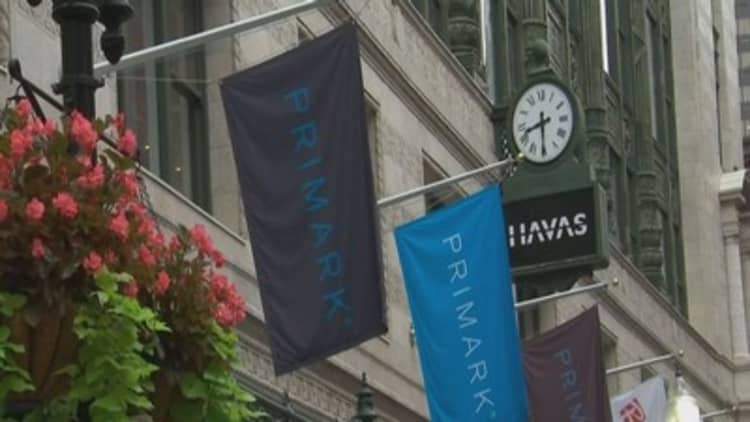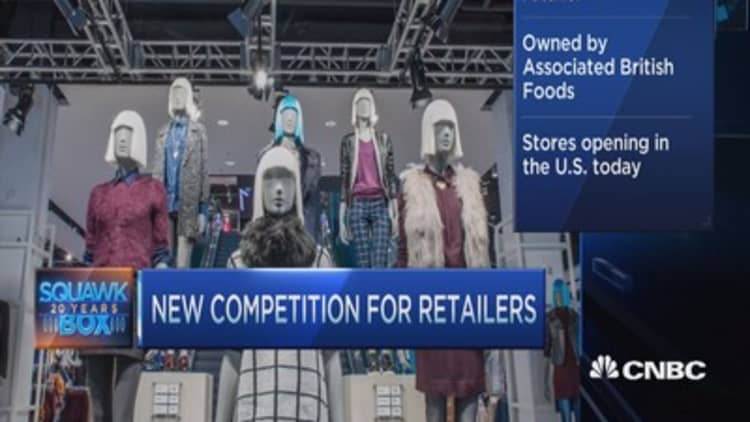
As if U.S. retail didn't have enough battles to fight, now it has to contend with the luck of the Irish.
Dublin-based fast-fashion retailer Primark opened its first U.S. store in Boston's Downtown Crossing this month. And more expansion is on the way.
Primark previously announced plans to open stores in King of Prussia mall, just outside of Philadelphia, in November and in New York's Staten Island Mall in 2016 along with several others in Massachusetts, Connecticut, New Jersey and Pennsylvania.
Now, a New York Post report says the cheap-chic retailer is working on securing a location in Manhattan. The paper cited an anonymous source who said it's eyeing locations that are similar to competitor H&M, though the trouble is finding a space big enough.
However, a Primark spokeswoman said the only store currently planned for New York is the Staten Island location.
Primark's Boston location is four floors and covers 77,000 square feet in the former Filene's location, which has been empty since the discount retailer closed its doors in 2007.
Like it's European stores, the Boston store is big, and the prices are low—and industry analysts already see it as a looming challenge to a host of other retailers.
"We believe the flagship was easy to shop/navigate and offers a compelling one-stop shop for a busy mom, a teen interested in treasure hunting for outfits and accessories, or a father looking for functional work clothing," said Oliver Chen, a retail analyst at Cowen & Co.
Owned by U.K.'s Associated British Foods, Primark began in 1969 and has 292 stores in nine European countries. Its hallmark is its low prices, fashionable design and decent quality. Much of the merchandise is priced at less than a pizza: $15 jeans, $14 sweaters, and $3 towels.
According to a Sanford Bernstein analysis, U.S. Primark prices on similar merchandise are 20 percent below Forever21, 30 percent below Gap's Old Navy and 40 percent below H&M.
Primark manufactures its own merchandise and said its technology, efficient distribution and volume buying enable its everyday low prices. It keeps its marketing spending relatively low, and doesn't have an online store. That means, it hasn't had to invest in e-commerce infrastructure.
"We find the store well organized and merchandised, and we like the youthful decor featuring a faux-industrial interior, neon signage and smartphone charging stations," Chen said.
Analysts warn retailers
"We view Primark as a new threat to department stores (Macy's), mothers shopping for family (Kohl's, Old Navy), and teen retailers given prices and full teen collections. Aggressive bra and sleepwear prices and children's key items may also impact L Brands and children's retailers (Ascena Retail Group and others)," Chen wrote to investors on Monday.
In the U.K., Marks & Spencer is one of the most frequent cross-shop bags at Primark, said Stacey Widlitz, president of SW Retail Advisors, based on observations of shoppers coming out of Primark stores. That means Kohl's, J.C. Penney and Macy's would be Primark's U.S. rivals.
"While many investors believe Primark is mostly for young people (18 to 35), the stores have a much broader representation. On any given weekend, the store is swamped with families stocking up on basics, fashion and home," Widlitz said.
But that doesn't mean department stores are the only retailers at risk. The teen space is the second-most in Primark's competitive crosshairs, Widlitz said. Based on her focus group research in Europe, "teens get their basics at Primark and then trade up a bit to H&M for fashion and then for big spend pieces head to TopShop," she said.
Widlitz further said that in the U.S., the equivalent teen players American Eagle, Aeropostale and, to a lesser extent, Abercrombie & Fitch, should pay attention.
"With [Primark] denim at $12, good luck competing. Old Navy has the most obvious overlap in terms of price points," she said.
One of Primark's strengths in Europe is its locations. Widlitz said several of Primark's London stores have the highest foot traffic and sales conversion of any retailer she tracks in Europe.
Former department store executive Jan Rogers Kniffen, CEO of J Rogers Kniffen, said scale is going to be key for Primark to begin really making a dent.
"They have almost 300 stores outside the U.S., and I think that they could have 300 here if the first 10 stores work," Kniffen said.

Once some level of scale is established, Kniffen said, "Primark will certainly be difficult for both the Gap, its Old Navy division, because they sell very similar product at even lower prices. It'll put a lot of pressure on teen retailers, that's Aeropostale, American Eagle, Abercrombie & Fitch, because they'll get really a lot of following from young customers who really like to buy something at a bargain. They'll put pressure on the J.C. Penney, Kohl's, and people like that, as well."
But so far, few U.S. retailers have addressed Primark at all, so if there is concern, it hasn't been voiced publicly.
In an August phone interview with CNBC, when asked how Primark could impact Abercrombie & Fitch, chairman Arthur Martinez said, "Primark is engaged in race to the bottom in terms of quality and price, not sustainable for ANF. Our objective is to deliver well-made, on-trend product, fairly priced, but we aren't seeking that stance."
Primark's challenges
Most analysts agree that it will take hundreds of stores and likely several years, to really take market share here. At the moment, the Boston opening was the first of eight planned U.S. by 2016.
Also, Primark does not sell anything on its website; it's merely set up as a blog and look book. While it is another way the retailer helps keep prices low, it is a challenge for consumers that expect online shopping options.
Also, other successful U.K. retailers, such as Tesco and Marks & Spencer, have failed in the U.S., ultimately closing up operations.
Chen said other expansion risks include "real estate selection, translation of styling to appeal to American shoppers, and trend-right assortment planning, and lack of precedents for quick success for European/Japanese entrants in U.S. market."
Still many, including Chen, think Primark will buck the trend of its European competitors in failed U.S. expansion.
Chen's ultimate thesis serves as a warning to U.S. retailers: "U.S. retailers should be worried given impressive depth and breadth [of Primark's] offering, daily replenishment strategy, elevated store service and alluring styling (basic apparel + trendy accessories). Existing retailers will need to intensify focus on diff
(UPDATED: This story was updated to include reports of the New York location.)




